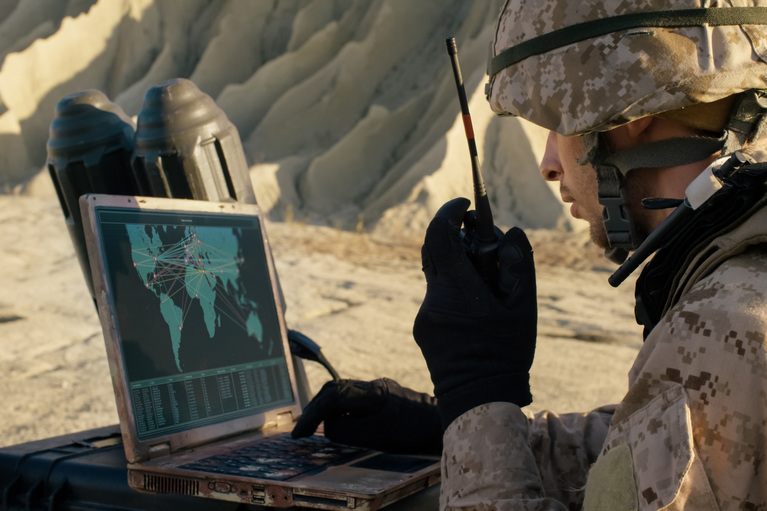
Compact, efficient power solutions enable improved countermeasure capabilities
Explore Vicor's efficient and reduced weight power delivery network for electronic warfare countermeasures systems
As 2023 marches on, we are seeing a growing trend within the aerospace and defense electronics industry toward technology standardization, in particular regarding power-delivery networks. The U.S. Department of Defense (DoD) and prime defense contractors are incentivized to push standardized, modular power systems thanks to their inherent reusability, ability to scale across multiple platforms, and the clear benefits of shorter development time and faster time to revenue.
By Matt Renola, Sr. Director Global Sales Aerospace and Defense and John Sturm, Global Vice President for Aerospace & Defense
While this may seem like a well-defined movement, power supplies – until the advent of hardware standards such as MOSA (Modular Open Systems Approach) and SOSA (Sensor Open Systems Architecture) – were largely an afterthought when it came to shifting from highly-customized designs to standard, off-the-shelf solutions.
In an all-too-common scenario, only once the system is specified and the logic and memory subsystems are designed does the question arise: “How are we going to power this thing?” At that point, there are typically very limited options. The engineer is left with a collection of power form factors to design for – some are shaped like half-moons or pentagons while others are accordion-shaped to accommodate flex PC boards. The engineer is then given a mechanical outline and space dimensions and asked, “Can you shoehorn in a power supply?”
The industry has been working like this for decades, absorbing the expense of custom power supplies that must also be reliably cooled – another critical design element that is too often left as a postscript. It’s as if someone built a car first, then considered how to power it.
Vicor has been powering defense applications for years and has learned that the power chain is still often relegated to late-stage design, or even retrofitted in some instances. It’s unfortunate, because earlier, serious consideration of the power delivery network can be a strategic advantage once you understand the design benefits of power modules.
That’s a habit we expect to change as the industry continues to embrace alignment with MOSA and SOSA standards. This is a positive trend, because we firmly believe that power should be at the forefront of all design considerations. Not only does it ensure a cleaner, less expensive, more power-efficient design, it guards against obsolescence in an industry where hardware is often expected to be in service for 20 or 30 years. Moreover, having a known power supply early in the design process can help to expedite the recertification process and simplifies logistics and inventory management.
The opportunity to transition to standard, module power systems is opening up in large part due to top-down pressure from the U.S. government. What does this evolution look like? We are seeing custom chassis and backplanes giving way to standardized designs with a consistent form factor across the entire application space, whether for an aircraft or an advanced radar array.
In this situation, the engineer plugs in a single-board computer and other instrumentation cards, and the predictable, pluggable power supply becomes an integral part, complete with specified voltage rails and output power. High-efficiency modules capable of supporting many different VIN/VOUT also enable greater flexibility and the ability to react quickly to design changes.
These power-density advancements will enable more power in the same space for future designs, which is enabling scalability through technology reuse. At Vicor, we appreciate that this long trend line is only possible if design engineers understand and appreciate the benefits of standard, modular power components. It’s a more strategic approach to power that yields faster designs, enhances overall system performance, and mitigates obsolescence.
This article was originally published by Military Embedded Systems.
John Sturm joined Vicor in 1997. He has over 33 years of experience in electrical design engineering, engineering management, business development, sales, and sales management. In his current role he is focused on leading the company’s business in the aerospace and defense market while developing key partnerships with prime contractors in the industry. Prior to Vicor he was with TDK Corp. of America and Grayhill Inc. John holds a B.S. in electrical engineering from the Illinois Institute of Technology and an MBA. in marketing and finance from the Lake Forest (Illinois) Graduate School of Management.
Matt Renola is Senior Director, Global Business Development – Aerospace, Defense and Satellite Business Unit at Vicor. Matt has been with Vicor for 15 years and has been responsible for managing the Vicor sales teams and global accounts in all of Vicor main vertical markets. He has over 30 years of technical sales and marketing experience and has also worked for major OEMs: Artesyn Technologies, Emerson Network Power and Vishay Intertechnology. He has an undergraduate degree from Boston College and an MSE from the University of Pennsylvania.
John Sturm, Global Vice President for the Aerospace & Defense
Matt Renola, Sr. Director Global Sales Aerospace and Defense
Compact, efficient power solutions enable improved countermeasure capabilities
Explore Vicor's efficient and reduced weight power delivery network for electronic warfare countermeasures systems
Providing well-regulated 48V at over 1kW
Learn how Vicor delivers power at 1kW with efficiency and reduced weight
Supporting more functionality, increased payload and longer run time
Learn how Vicor delivers high power with efficiency and reduced weight that allows for greater payload options to support mission success
Reducing I2R losses to enable extended missions
Learn how Vicor delivers high power with efficiency and reduced weight for electronic countermeasures





